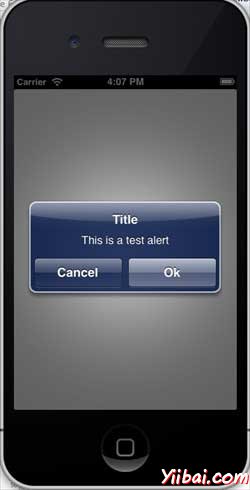iOS - Alerts(警示)
使用警示Alerts
警示(alert )是用来给用户的重要信息。只有 Alert 视图中选择该选项后,我们才能进一步使用的应用程序。
重要的属性
-
alertViewStyle
-
cancelButtonIndex
-
delegate
-
message
-
numberOfButtons
-
title
重要的方法
- (NSInteger)addButtonWithTitle:(NSString *)title
- (NSString *)buttonTitleAtIndex:(NSInteger)buttonIndex
- (void)dismissWithClickedButtonIndex: (NSInteger)buttonIndex animated:(BOOL)animated
- (id)initWithTitle:(NSString *)title message: (NSString *)message delegate:(id)delegate cancelButtonTitle:(NSString *)cancelButtonTitle otherButtonTitles:(NSString*)otherButtonTitles, ...
- (void)show
更新ViewController.h“如下:
让类符合加入警示(alert)视图委托协议<UIAlertViewDelegate> ,在ViewController.h 如下图所示:
#import <UIKit/UIKit.h> @interface ViewController : UIViewController<UIAlertViewDelegate>{ } @end
添加自定义的方法addAlertView
-(void)addAlertView{ UIAlertView *alertView = [[UIAlertView alloc]initWithTitle: @"Title" message:@"This is a test alert" delegate:self cancelButtonTitle:@"Cancel" otherButtonTitles:@"Ok", nil]; [alertView show]; }
实现警报视图委托方法
#pragma mark - Alert view delegate - (void)alertView:(UIAlertView *)alertView clickedButtonAtIndex: (NSInteger)buttonIndex{ switch (buttonIndex) { case 0: NSLog(@"Cancel button clicked"); break; case 1: NSLog(@"OK button clicked"); break; default: break; } }
更新在ViewController.m 中的 viewDidLoad 如下
(void)viewDidLoad { [super viewDidLoad]; [self addAlertView]; }
输出
现在,当我们运行程序时,我们会得到下面的输出。


